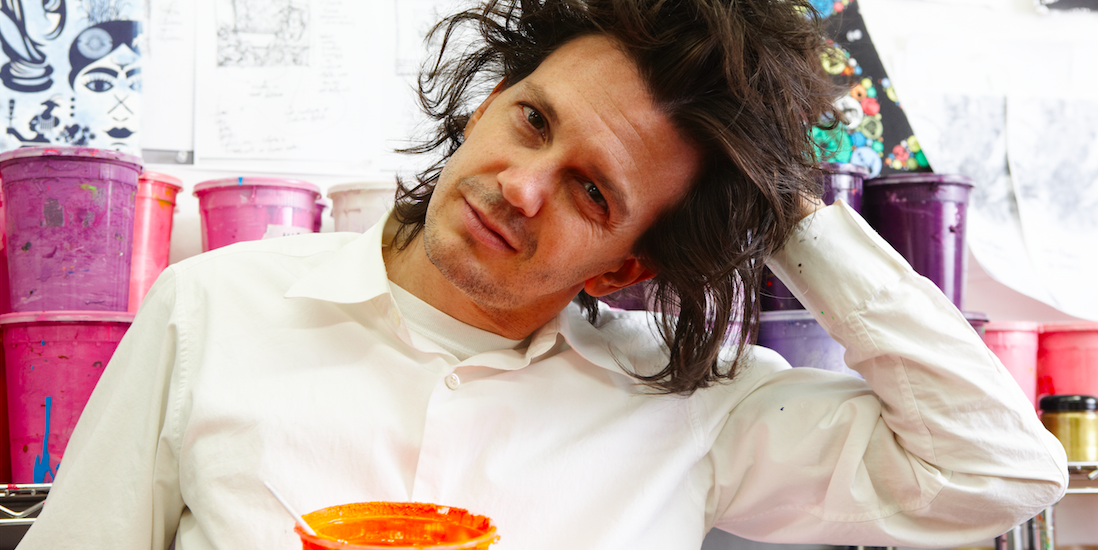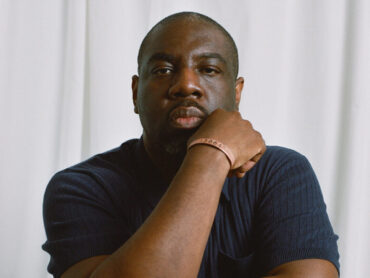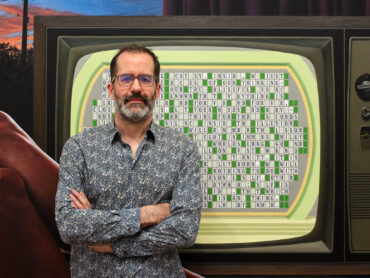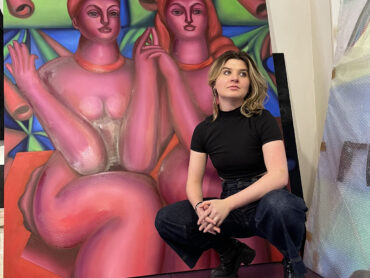Swizzling, Drizzling drops of dew
Tribal swirls, more than a few
Sideways, upwards, outside the line
A densely layered, study of design
Elemental beds that haven’t been groomed
Vermillion crustaceans and flowers half bloomed.
Slices of citrus that have flat faces
And hands reaching out of various places
It’s bondage, it’s freedom, and light to discover
A keyhole, a perspective and time, as it’s lover
Donnalynn Patakos
I sat one afternoon investigating the nuances and overall genius of the magical, elementally filled space on some work created by Ryan McGinness. Gloriously charged with color, twisting and turning with hints of shimmer from metal leaf elements sprinkled like silvery scales flickering. It is like a dream when you are someplace you name home, but you are not there. It is someplace else. It is someone you know, but not them. Or the simplicity of something familiar and candid. I can only imagine how entertaining the works must be at different times and in other settings. At times, it almost feels like you are discovering a lost land that once existed, amidst a tower of ivory, unpruned and waiting to be found.
On October 15- November 14, the Miles McEnery Gallery in N.Y.C. will have a show where Ryan will place seventy-two unique works on linen, huddled up next to each other, six feet high, representing his height and 72 works for the year he was born. The pieces along the walls will have a look and feel of one large mural but can be taken apart or put in a new order, creating a fresh narrative for the viewer, or a reunion of sorts, like relatives, visiting. The artist wanted to challenge himself, yet be able to sell the pieces individually.
The beautiful layering and bright colors are captivating and keep your attention for more than a moment and are immensely peaceful amongst the chaos.
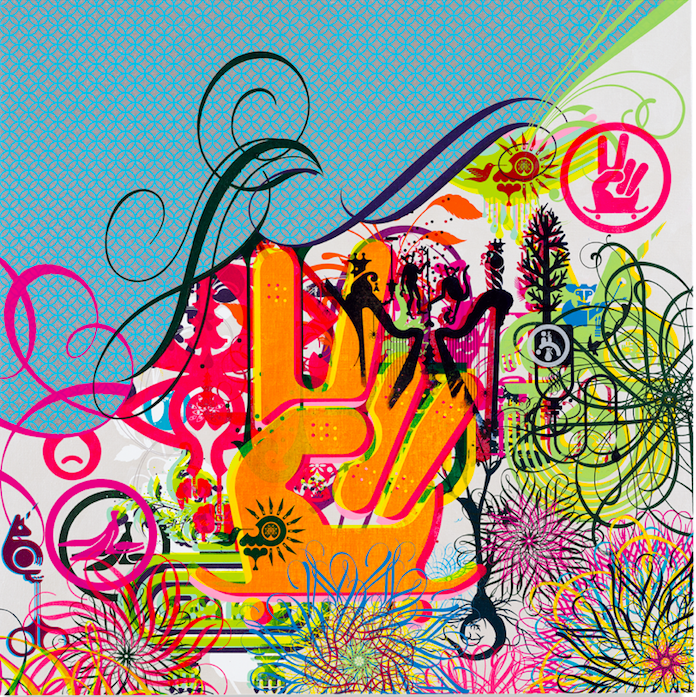
Ryan McGinness Mindscape 57 2019 Acrylic on metal leaf on linen 36×36″ (61x61cm) photo courtesy of Miles McEnery Gallery ©Ryan McGinness/Artists Rights Society (ARS) New York
As a young man, Ryan was very influenced by the Dada movement. Dada was the first conceptual art movement where the artists’ primary goal was not creating art with conformist aesthetics but on creating works that were considered “Anti Art” that challenged society on how they viewed the artist’s purpose art. With artists like Duchamp, Man Ray, Francis Picabia. Dada artists are known for their use of everyday objects that could be bought and presented as art with little interference by the artist. The use of the readymade forced questions about creativity and the very definition of art, and it’s purpose in society.
D.P.- What impressed you most about the Dada movement, and do you think it is time for a new campaign, given what’s happening in the world?
R.M.- When I was in high school, I came across a book in my local public library about Dada. I was immediately taken with not the political agenda (which was not something I could relate to), but rather, the total rejection of reason. At the time, I was beginning to understand that meaning and reality was a construction of signs and symbols. Culture was a myth! I loved how the Dadaists turned it all upside down. And, I related their work to that of one of my favorite bands, They Might Be Giants. This must have been around 1986. I saw Dadaism as a grim wackiness that was, in a much more vivid form, also expressed in Pee Wee’s Playhouse. An art movement from the early 20th century and a band and a television show from the mid-1980s? It somehow made sense to me because I found a freedom in free association—a freedom to construct meaning instead of relying on a dictated meaning. Power is reality control, and I wanted to assume that power for myself. There are two ways in parallel to do that: build your own personal reality, and build a moat of meaninglessness around it to protect yourself. In 1992 I got DADA tattooed on my left arm. And, yes, it is always time for a new movement!
D.P.- On the Party series- What made you think of doing 50 parties in 50 days? What was your favorite theme?
From June 2009 to June 2010, I hosted 50 parties in my studio in downtown Manhattan. Each party took place on Friday night and had a different theme. The project was the culmination of many different interests. First and foremost, I’ve always enjoyed orchestrating activity-centered social gatherings—game nights, dinners, cocktail parties, openings, and performances or performance-esque events. And with my exhibitions, it’s always been important to me to locate my work within site-specific installations by allowing my paintings to expand beyond their picture planes and into the white cube. This urge to host and create installations—not to entertain but to engage—drove the planning and programming of the parties. And while I am not a social person, I always felt that if I could create the social systems, then the guests who populate them would take care of themselves. With the 50 Parties project, I wanted to create plans for parties that could be shared like computer programs or party codes for anyone anywhere to replicate. The entire project has been archived at 50Parties.com. My favorite party was the Labor Party because it was the most productive.

50 Parties Invitations (50 Parties.com)
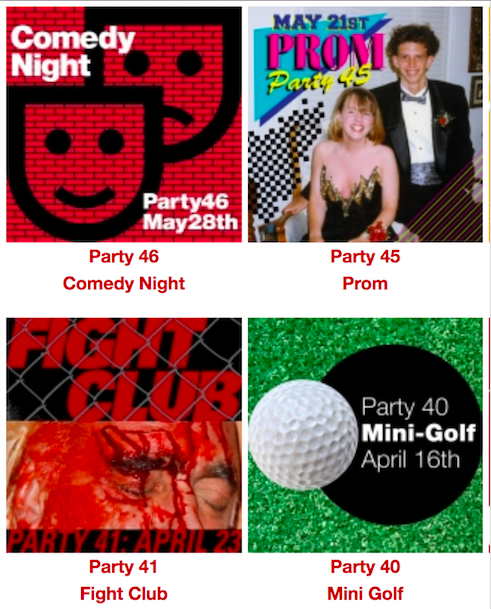
50 Parites Invitations (50parties.com)
D.P.- Tell me about your story and exhibition with the Warhol Flowers and why you felt that the original series was grossly underrated.
R.M.- Warhol is often cited when people write about my work. I suppose this is for the obvious reason: silkscreening. Or perhaps because we’re both products of Carnegie Mellon University. Or because I worked at the Andy Warhol Museum. I have had a love/hate relationship with the ghost of Warhol since he passed away, so I finally decided to address his work head-on by reinterpreting the Flowers. Andy Warhol created the series in 1964 and 1965 and continued the series through the late 1960s. He produced over 900 Flowers paintings in total. The artwork for the Flowers paintings was based on a photo of hibiscus flowers by Patricia Caulfield. Her photograph appeared in the June 1964 issue of Modern Photography in an article that demonstrated Kodak’s new color processor. Warhol cut out the magazine page, cut up and reconfigured the composition, and made several black-and-white photocopies in an effort to increase the contrast to purely black and white. The artwork Warhol created is best described as a photocopy of a photocopy (10 times) of a magazine page (CMYK offset printed) of a photo of a color photo-print made with a Kodak Rapid Print color processor. This is what the paintings are about: reproduction and the latest image-processing technology at the time—the color processor by Kodak. The flowers are the primary subject; the subtext is all about image reproduction and symbolizing the subject.
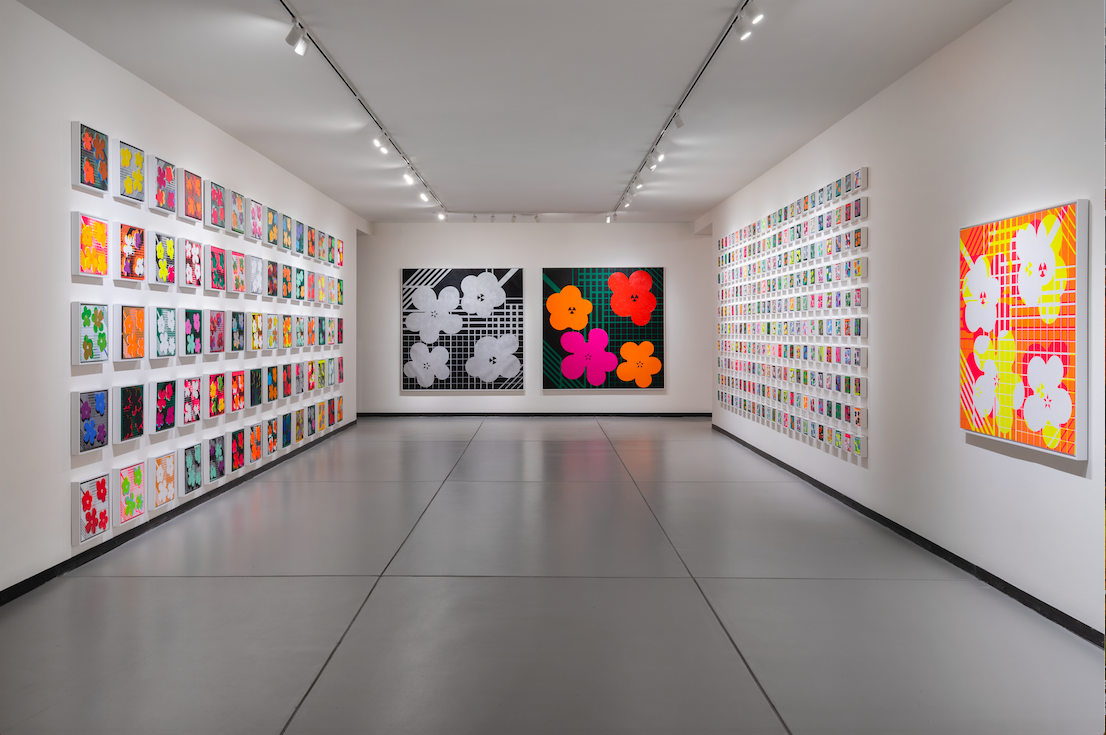
Warhol Flower Icons: Ryan McGinness, Warhol Flower Icons, 2019, Installation view, Baldwin Gallery, Aspen, Photo courtesy of Ryan McGinness Studios, Inc. / Art Resource, NY, © Ryan McGinness / Artists Rights Society (ARS), New York”
D.P.- Is there a different satisfaction in putting a book together, which has to be structured, and setting icons wherever you like or creating an environment with liberal autonomy? What appeals to you on both?
R.M.- It is all the same to me. It’s all composition. The paintings are highly structured and are composed to look chaotic. Some of my books also look chaotic.
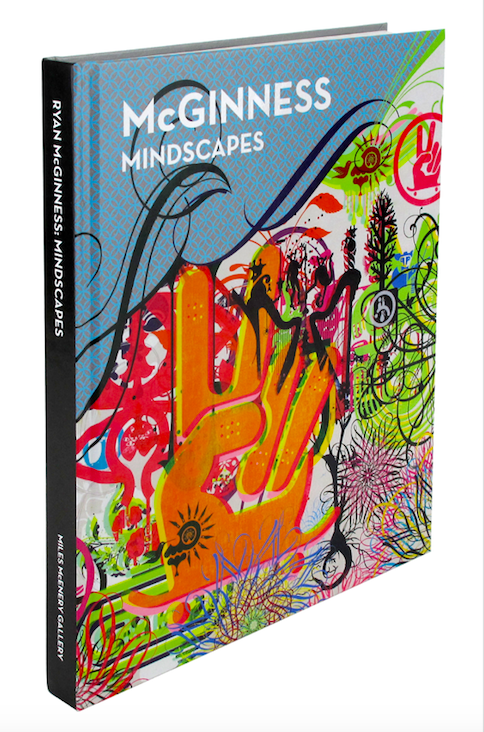
Mindscapes 2020 11×8.5 in (27.9x 21.6cm) 4C 208 pp. Hardcover, Published by Miles McEnery Gallery
D.P.- What art group crew, scene, would you say you belong? Graffiti, conceptual?
R.M.- None, but a few groups have attempted to adopt me. There is a quiet, desperate pride to homelessness.
D.P.- What would you most like to be commemorated for in the timeline and history of art?
R.M.- My contribution to art history is the assertion of my aesthetic. That is, the iconic universal symbols I draw and the way I present the world within me. These precise pictographic images force us to reconsider what is allowed to be art since this aesthetic has historically been reserved for anonymous authoritative communications—messages with purpose and utility, not personal poetic artistic intentions with authorship and accountability.
D.P.- You take icons inspired by street signs which, by nature, are easily identifiable with a sense of conformity and turn it into controlled chaos with a message. What is the desired outcome for the viewer? How does it feel to build communities of iconography? Do you ever sit back and laugh about what you have commingling for the viewer?
R.M.-One of the qualities of art that makes it so magical is the gap between intention and interpretation. That gap can be designed to be wide or narrow. I like to think that it is uncomfortably narrow in my work because I create drawings that beg for interpretation.
D.P.- Do you scrap something if you don’t feel it is perfect, or are you more relaxed about “happy accidents?”
R.M.- I do paint over or sand down paintings when I feel I have lost control. And, I allow for a degree of wabi-sabi in the work.
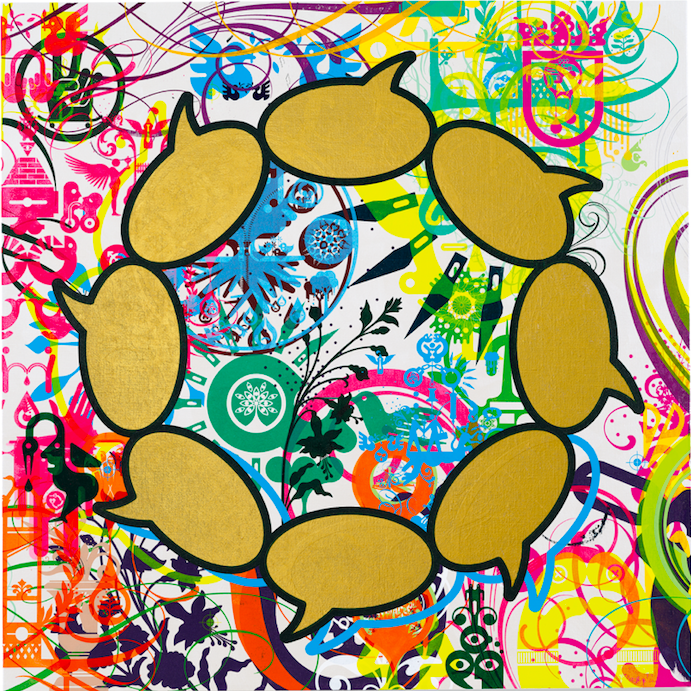
Mindscape 5 Photo courtesy of Ryan McGinness Studios, Inc. / Art Resource, NY, © Ryan McGinness / Artists Rights Society (ARS), New York
D.P.- What truth are you seeking in your process?
R.M.- There is a “truth” inherent in the drawings I make, and I am trying to find that by going through a sketch process. By “truth,” I mean that the images want to be something, and I am trying to figure out what that is. I know that may seem mystical or even corny, but I have found that by going through a sketch process of progressive iterations, I am able to find the solution for each drawing. The images end up not as representations; rather, they are primary presentations having lost their reliance on the original referent. This is critical in understanding exactly what a symbol is. It is not a representation. It is the thing! The process includes sussing out the underlying geometry to the point where, in the final stage, I make technical drawings with computer drafting tools. Each final drawing is digital information stored as an equation and visualized as scale- and resolution-shifting vector files. The truth is a drawing as pure information. These bits of information can be infinitely remixed and serve as the base ingredients for my paintings, sculptures, prints, products, installations, videos, etc. This information is not reproduced. The information is used to create an infinite variety of new and unique productions giving rise to multiple materializations.
D.P.- Tell me about Green Suede Filth- and if you had an art band, who would be in it?
R.M.- G.S.F. was a band I was in with a friend of mine when we were in high school in Virginia Beach in the mid-80s. The experience of creating something that resonated with other people was intoxicating. Exploring propaganda techniques, merchandising, and meaning construction helped me uncover what was at the core of my identity and informed my decision to go on to formally study art and design. And I do currently have an art band! (Although, we make no music.) Cross-pollinating with my creative friends is one of the reasons why I live and work in Manhattan. Everyone should be in a band.
D.P.- Where do you think there is a gaping hole in the linear progression of art in history?
R.M.- The discipline of creating legible universal images emerged as the world began to shrink in the early 20th century. However, this strategy for image-making was soon co-opted by the state and industry because it effectively communicated to a broad audience. This aesthetic pursuit spun off from the formal canon of art history. I’m referring primarily to the Cologne Progressives, Franz Seiwert, Gerd Arntz, and Heinrich Hoerl as well as Augustin Tschinkel. And later, the visual languages developed by Otl Aicher and Lance Wyman turned this aesthetic into tools for clear and precise communication. Fast forward to Keith Haring, and one can begin to see the through-line. I would love to curate an exhibition that strings these artists together in order to close that gaping hole.
D.P.- Explain what you mean by art has no “use”?
R.M.- Art has no utility, but art can be very useful. Art is the expression of ideas. In that regard, art is the host. Just as we all are hosts. A host has no use if there is no party. We are only as useful as the parties we express.
D.P.- What is something you have found yourself doing now that you would never have done ten years ago?
R.M.- Arguing with offspring
His work is included in the permanent collections of The Metropolitan Museum of Art, New York, NY; Museum of Modern Art, New York; NY; Virginia Museum of Fine Arts, Richmond, VA; Museum of Contemporary Art, San Diego, CA; The Albright-Knox Art Gallery, Buffalo, NY; MUSAC, Museo de Arte Contemporáneo de Castilla y León, León, Spain; The Taguchi Art Collection, Tokyo, Japan; The Charles Saatchi Collection, London, England; Cranbrook Art Museum, Bloomfield Hills, MI; The Pizzuti Collection, Columbus, OH; Saastamoinen Foundation, EMMA, Espoo Museum of Modern Art, Espoo, Finland; New York Public Library, New York, NY; Norton Family Foundation; Cincinnati Art Museum, Cincinnati, OH; UBS Collection, New York, N Y; J. P. Morgan Chase Art Program; M T V Networks; The Neuberger Berman Collection; Hallmark Art Collection; The Schwab Family Collection; Gilberto e Rosa Sandretto Collection; The Malingue Collection; Sammlung Plum & Akzo Nobel Art Foundation; The Richard E. Jacobs Group; The Shockey Family Collection; Cora Diamond Corporation; The Judy & Rob Mann Collection; Orrick, Herrington & Sutcliffe; The Phil Schrager Collection; The Michael Krichman & Carmen Cuenca Collection; The Matthew & Iris Strauss Collection.
The show will be October 15-November 14, 2020 at the Miles McEnery Gallery
